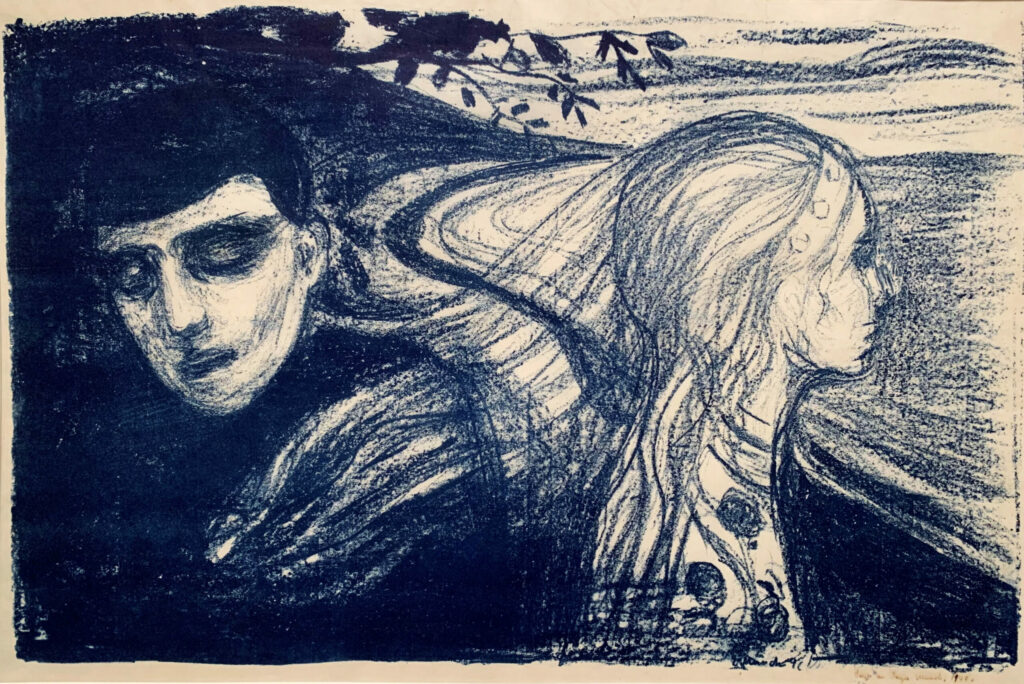
Separation II continues the story of a relationship, one that Munch begins to tell in Attraction I. Both will be on view in just a few weeks at the IFPDA fair, presenting us with a wonderful opportunity to discuss them in conjunction with one another. Connected with the larger story told in Munch’s Frieze of Life, these two pairs also contain a micro-narrative of their own, acting almost like a diptych where appearances deceive.
To recap Attraction I, two lovers are drawn to each other both by and in spite of a foreboding aura. This allegorical couple is aware of the potential pain love might bring and choose to pursue each other anyway. Here, the man and the woman look almost identical: two halves of a now-forming whole. Visual sameness reflects the comfort of emotional mirroring; our lovers see themselves in each other. Then in the next chapter of the story, we come across two opposite entities, an unequal duet of sorrow and indifference. The same man and woman who once gazed so intensely into each other’s eyes are now turned completely away from each other. The prophecy of Attraction I has been fulfilled by the severing of the pair in Separation II.
Visually, Separation II displays a very strong juxtaposition between light and dark tones in the printmaking process, working to further contrast the two figures here. On the left we see the man (no doubt representing Munch) drenched in shadow at the edge of the woods. His face and body turn away from the woman just enough to indicate his sadness but toward us. Because he is facing the viewer, we can see his downcast eyes and pained expression. This position creates a greater sense of vulnerability than we get from his female counterpart. Their contrasting body languages suggest two completely different experiences of the same event. While he appears solitary and rooted, she floats in profile toward the lighter half of the print. In the background behind her lies the open, never-ending sea. Her chin is raised and she looks toward the future this separation has granted her, leaving him behind.
Munch himself identified an intentional symbolism specifically in the woman’s hair, borrowed from the real experience of ending things with Millie Thaulow. In one of his journals* he described their farewell by focusing on her hair as she walked away from him. Even when she was no longer in view, Munch did not feel fully separated from her. These “invisible threads” coiled around him, causing him a physical pain he could not severe himself from. In Separation II, this hallucinatory metaphor is rendered tangible. Her hair trails behind her and even shrouds his left shoulder as he shrinks into the woods. The “connection between the divided pair” flows from her windblown locks and remains in the feelings he cannot shake.
In a later journal, Munch equates a woman’s hair to that of Medusa in the very same Frieze of Life series, bringing in images of writing snakes and men stopped dead upon eye contact. (The stationary positioning of the man in Separation shares similarities with Medusa’s male victims in his inability to move.) While a harsher point of view, it fits with his frequent equating of ex-lovers to demonic creatures.
We have often discussed Munch’s tumultuous relationships with women, so we’ll refrain from repeating too much. But in looking at his work in any capacity, it’s virtually impossible to avoid mentioning the likes of Millie Thaulow and Tulla Larsen. What is unique in the Attraction-Separation series is the role of choice. At first, in Attraction, it seems like neither party can help themselves but fall in love. But later, in Separation, this man remains entangled while the woman (probably Millie, but could be an amalgamation of many lost lovers) sets herself free. He retreats to the forest, a place where Munch felt much safer than he did by the ocean, where the woman floats away to. We could see his fate from Munch’s point of view, the projection of his own self-pity. He has been left, trapped by an inability to move on. Yet, he chooses to stay, not to follow her around and maintain his coils. Eventually, he might realize he was also set free.
Courtesy of John Szoke Gallery, New York.
